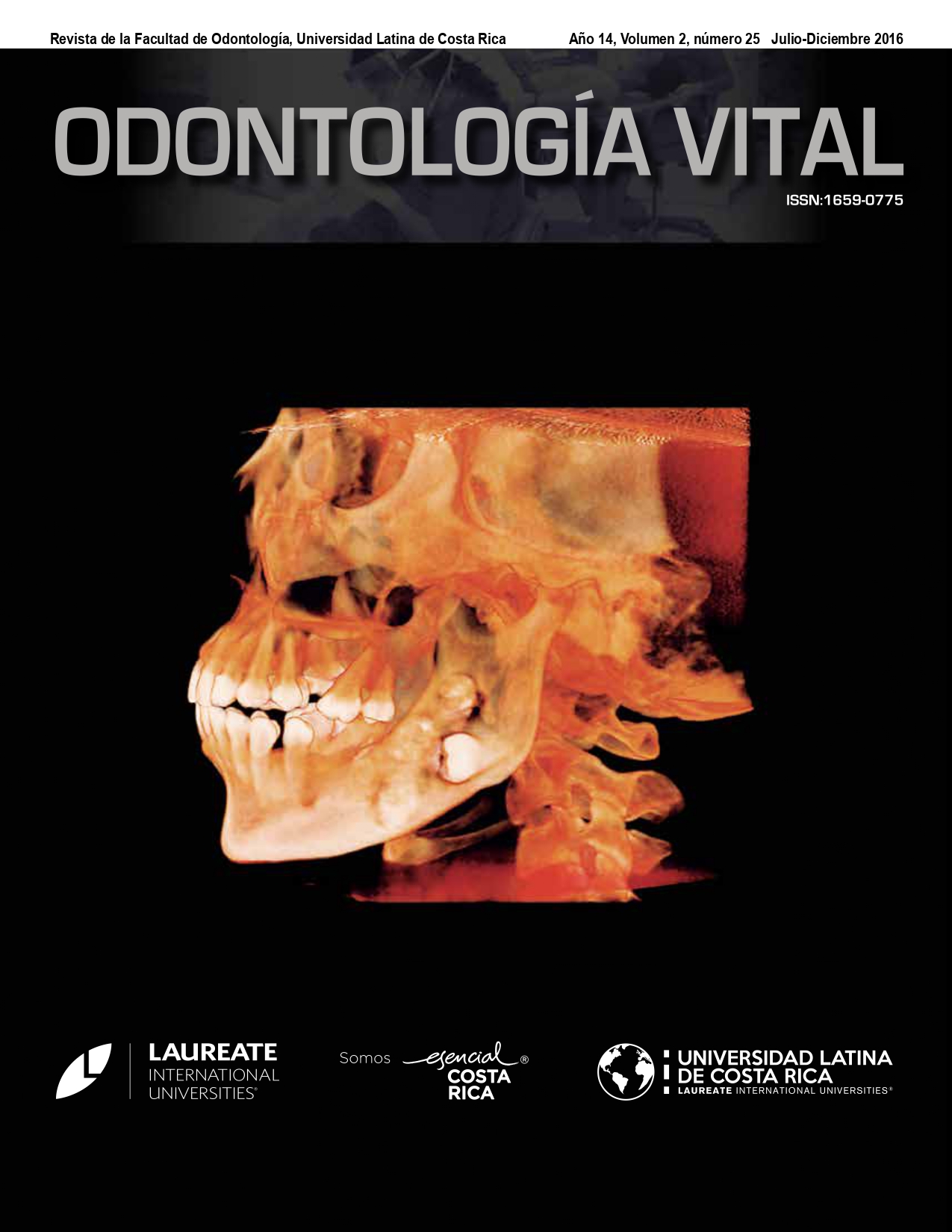Evaluation of filtration at endodontical obturation at crown-apical area when different barrier methods are used
DOI:
https://doi.org/10.59334/ROV.v2i25.244Keywords:
Intracoronal sealing, filtration crown apical, barrier methodAbstract
This study analizes and compares the intracoronal sealing of 50 extracted, single rooted, human dental organs that underwent endodontic treatment; they were divided in 5 groups of 10 each, applying the materials used as barrier method: Cavit G, Ketac Molar, Perma Seal, Single Bond and to 4 groups and leaving one control group without any barrier material. Afterwards they were submerged in artificial saliva for 1 month; after this time they were stained with methylene blue at 2% and proceeded to make the cuts for their study, evaluating crown apical filtration in 7 sections of 1 mm each along the entire root length starting immediately after the material used as a barrier method.
Results: found that the adhesive Single Bond was the most effective as material barrier to avoid crown-apical filtration.
Downloads
References
Al-Boni, R., Raja, OM. (2010). Microleakage evaluation of silorane based composite versus methacrylate based composite. J Conserv Dent. 13(3):152-518. https://doi.org/10.4103/0972-0707.71649
Al-Maqtari, AA, Lui, JL. (2010). Effect of aging on coronal microleakage in access cavities through metal ceramic crowns restored with resin composites. J Prosthodont.19(5):347-356. https://doi.org/10.1111/j.1532-849X.2010.00593.x
Attam, K, Talwar, S. (2010). A laboratory comparison of apical leakage between immediate versus delayed post space preparation in root canals filled with Resilon. Int Endod J. 43(9):775-781. https://doi.org/10.1111/j.1365-2591.2010.01742.x
Bailón, SM. (2011). Capacidad de sellado de materiales diferentes en dientes tratados endodónticamente. Med Oral Patol Oral Cir Bucal. 16 (1):105-109.
Camejo, SM. (2009). Efecto de algunas técnicas utilizadas en la realización del tratamiento de conductos radicu-lares en la microfiltración coronaria. Acta Odontológica Venezolana. 47(1):1.
Camejo, SM. (2009). Capacidad de sellado marginal de los cementos provisionales IRM, Cavit y Vidrio Ionomérico, en dientes tratados endodóncicamente. Acta Odontológica Venezolana. 47(2):1.
Ciftçi, A, Vardarli, DA, Sönmez, IS. (2009). Coronal microleakage of four endodontic temporary restorative mate-rials: an in vitro study. Oral Surg Oral Med Oral Pathol Oral Radiol Endod. 108(4):67-70. https://doi.org/10.1016/j.tripleo.2009.05.015
Ebert, J, Löffler C., Roggendorf, MJ, Petschelt, A, Frankenberger, R. (2009. Clinical adhesive sealing of the pulp chamber following endodontic treatment: influence of thermomechanical loading on microleakage. J Adhes Dent. 11(4):311-317.
Fakhri, M, Seraj, B, Shahrabi M, Motahhary, P, Hooshmand, T. (2009). Effect of salivary contamination on mi-croleakage of resin composites placed with a self-etch adhesive in primary teeth: an in vitro study. Pediatr Dent. 31(4):334-339.
Goldberg, F. Soares, I. (2002). Endodoncia técnica y fundamentos. Editorial Médica Panamericana. Argentina. (11): 181-191.
Hilú, R, Balandrano, Pinal F. (2009). El éxito en endodoncia. Endodoncia .27 ( 3):131-138.
Kranz, S, Guellmar, A, Völpel, A, Gitter, B, Albrecht, V, Sigusch BW. (2011). Photodynamic suppression of Enterococ-cus faecalis using the photosensitizer mTHPC. Lasers Surg Med. 43(3):241-248. https://doi.org/10.1002/lsm.21046
Lewis, B. (2010). The obsolescence of formocresol. J Calif Dent Assoc. 38(2):102-107. https://doi.org/10.1080/19424396.2010.12221772
Messer, H. y Wilson, P. (1996), Preparación para restauración y colocación de cemento temporal. Endodoncia. Principios y práctica, (Walton R. y Torabinejad M.), 2º Edición. Editorial McGraw-Hill Interamericana. (15): 292-293.
Pardi, G, Guilarte, C, Cardozo, EI, Briceño, EN. (2009). Detección de Enterococcus faecalis en dientes con fracaso en el tratamiento endodóntico. Acta odontol. venez.47(1):110-121.
Parekh, B1, Irani, RS2, Sathe, S2, Hegde, V2. (2014). Intraorifice sealing ability of different materials in endodonti-cally treated teeth: An in vitro study. J Conserv Dent. 17(3):234-247. https://doi.org/10.4103/0972-0707.131783
Pramod, K, Ansari, SH, Ali, J. (2010). Eugenol: a natural compound with versatile pharmacological actions. Nat Prod Commun.5(12):1999-2006. https://doi.org/10.1177/1934578X1000501236
Rahimi, S, Shahi, S, Kimyai, S, Khayyam, L, Abdolrahimi, M. (2010). Effect of calcium hydroxide dressing on mi-croleakage of composite restorations in endodontically treated teeth subsequent to bleaching. Med Oral Patol Oral Cir Bucal. 15(2):413-416. https://doi.org/10.4317/medoral.15.e413
Rodríguez, GC, Jácome, MJ, Perea, ML. (2010). Estudio comparativo de filtración microbiana coronal con tres di-ferentes materiales de restauración provisional en dientes obturados con Guttaflow. Revista Odontológica Mexi-cana. 14(1): 21-31.
Slutzky-Goldberg, I, Slutzky, H, Gorfil, C, Smidt, A. (2009). Restoration of Endodontically Treated Teeth Review and Treatment Recommendations. Int J Dent.150-251. https://doi.org/10.1155/2009/150251
Tanomaru, J1, Tanomaru, M, Maraísa, Verri, Watanabe E, Ito, I. (2009). Actividad Antimicrobiana de diferentes tipos de cementos endodónticos. Acta Odontológica Venezolana. 47(3):1-7.
Tapsir, Z1, Aly, Ahmed HM, Luddin, N, Husein, A (2013). Sealing ability of various restorative materials as coronal barriers between endodontic appointments. J Contemp Dent Pract.. Jan 1;14(1):47-50. https://doi.org/10.5005/jp-journals-10024-1268
Topaloglu, Ak A, Riza, Alpoz A. (2010). Effect of saliva contamination on microleakage of three different pit and fissure sealants. Eur J Paediatr Dent.11(2):93-96.
Vijay, R, Indira, R. (2009). Effect of glass-ionomer cement as an intra-canal barrier in post space prepared teeth: An in vitro study. J Conserv Dent. 12(2): 65–68. https://doi.org/10.4103/0972-0707.55620
Zarenejad, N, Asgary, S, Ramazani, N, Haghshenas, MR, Rafiei, A, Ramazani, M. (2015). Coronal microleakage of three different dental biomaterials as intra-orifice barrier during nonvital bleaching. Dent Res J. 12(6):581-588
Zarow, M, Steinder J. (2009). Strategies for posterior teeth reconstruction after endodontic treatment: a case report. Ann Acad Med Stetin. 55(2):53-58.
Zmener, O. (2009). Mejorando el sellado coronario en Endodoncia. Endodoncia. 27(4):201-209.
Downloads
Published
Issue
Section
License
Copyright (c) 2016 Myrna Delia Salinas Quiroga, Guillermo Cruz Palma

This work is licensed under a Creative Commons Attribution 4.0 International License.
Authors who publish with Odontología Vital agree to the following terms:
- Authors retain the copyright and grant Universidad Latina de Costa Rica the right of first publication, with the work simultaneously licensed under a Creative Commons Attribution 4.0 International license (CC BY 4.0) that allows others to share the work with an acknowledgement of the work's authorship and initial publication in this journal.
- Authors are able to enter into separate, additional contractual arrangements for the non-exclusive distribution of the Odontología Vital's published version of the work (e.g., post it to an institutional repository or publish it in a book), with an acknowledgement of its initial publication.
- Authors are permitted and encouraged to post their work online (e.g., in institutional repositories or on their website) prior to and during the submission process, as it can lead to productive exchanges, as well as earlier and greater citation of published work.







